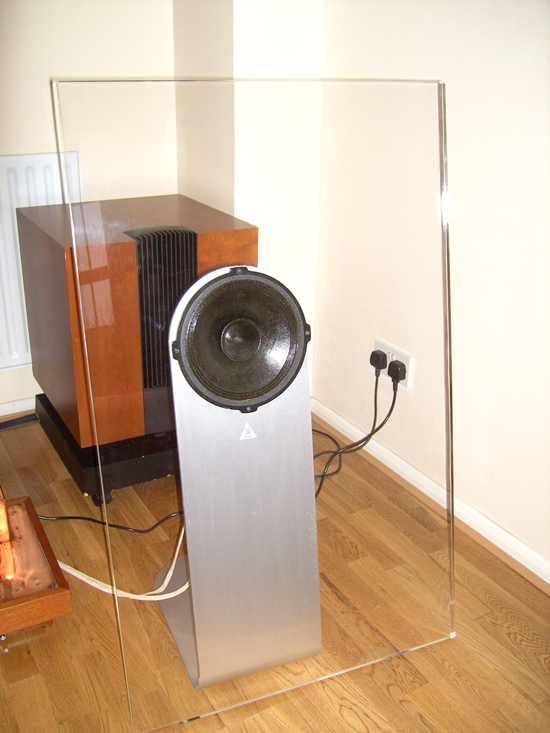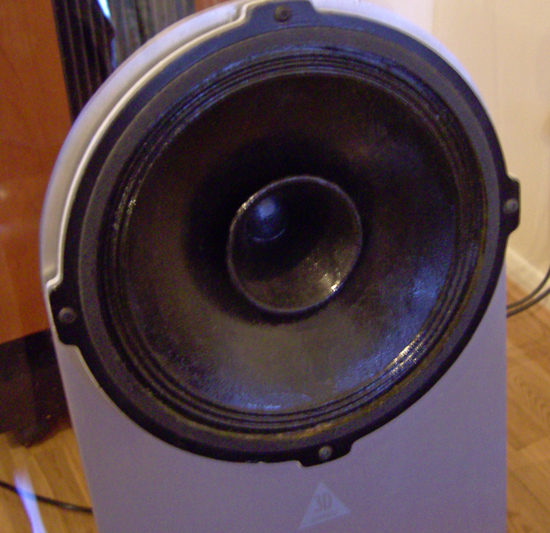The Test System
Before we go on to look at some of the PC software and hardware out there, I'll offer up a quick overview of the test system. Some of the components used really are out on a limb with price tags that are not for the faint of heart. In audiophile currency, I probably have what amounts to a mid-budget system. If your interest is in low budget products, be warned that the rest of this page will probably make your stomach churn. However, you've not been forgotten and we will add a few suggestions here and there should you have champagne tastes on beer budgets - as most of us probably do, especially in this time of credit crunch.
Speakers
 |
Real Hi-Fi owner and Supravox distributor Matthew Jameson was kind enough to provide us with a pair of test speakers based upon Supravox Signature Bicone Drivers known as the Transparence from a company called 3D Sonics. The Bicone Signature driver is a high efficiency (claimed 96dB sensitive) wide bandwidth design featuring a whizzer cone to supplement high frequency reproduction while the main cone takes care of the rest. The parameters of these drivers make them eminently suitable for an open baffle design like the Transparence.
If you keep your ear to the ground in loudspeaker circles, you'll know that open baffle loudspeakers have made a marked resurgence over the last five years or so. One of the chief perpetrators of this revival was a fellow named Throsten Loesch. Thorsten publicized his build of the Supravox Bicone Sig's using the very design that went on to become the 3D Sonics commercial venture. The remarkable simplicity was just what many in the DIY audio community were looking for: an easy to build high performance loudspeaker that could use a variety of drivers according to budget. I had the pleasure of listening to these speakers around five years ago at Thorsten's house; needless to say, it was an experience I never forgot. The absence of a walled cabinet allows the sound to fly out in all directions creating a soundstage that simply makes the loudspeaker drivers disappear.
All good things come with a slap around the cheeks and here's the part that the standard "boom 'n tizz" audio loving public won't like: the price tag is around £2400 UKP for a pair of these beauties. In audiophile markets, a price tag like this is hardly sweat inducing as there are plenty of high-end designs that cost multitudes more. If you are worried about the price, there's no reason to fret as DIY'ing a pair yourself that should get within 95% of the commercial model is not out of the question.
 3D Sonics makes an in-house change to the drivers that involves coating them with a few layers of C37 lacquer to humanize the sound. |
Stock signature Bicone drivers are available for DIY endeavors from Supravox USA, Supravox France for the EU, and direct from Real Hi-FI for the UK at around a third of the cost of the "ready to go" Transparence. If that's still too much for you, another door is open by using the budget friendly Visaton B200 driver with suitable baffle adjustments to suit its parameters.
The Transparence design is fiendishly simple: a single driver in a 6'x4' acrylic baffle that uses an aluminum L-bracket as a stand and as a means of providing additional rigidity to the baffle. There's no crossover as the driver covers the range of 50 Hz to 15 KHz on its own. That's most of the audible range covered by a single point source. While the top-end extension is enough even for super ears, the low-end obviously needs augmenting with a subwoofer for bass heavy music. For this purpose I use a Linn AV 5150 subwoofer crossed over at around 48 Hz that integrates very well with these speakers, especially when we use DRC to level some of the room response abnormalities.
Whether or not you have the financial clout to buy the fully fledged 3D Sonics Transparence, it's certainly worth investigating the sonic landscape that open baffle designs can create. The availability of drivers for just about every budget leaves the onus of their use squarely in the hands of the DIY'er. Don't pass up the chance to try them out.










114 Comments
View All Comments
kleshodnic - Monday, December 1, 2008 - link
Uh, just go digital out (TOS/link or HDMI) to a receiver and let ther receiver do the DAC'ing.Want a better DAC? Buy a better receiver. Not only will you get the better DAC, you will get a ton of other great features with a higher end receiver.
All this talk about computer audio is assuming that you would want to come analog out from the computer. WHY?
phusg - Tuesday, December 2, 2008 - link
It would be a lot easier I agree, but AFAIK only really expensive top-end receivers can challenge the analog out you can get from a quality consumer audio card with upgraded opamps, especially when it comes to stereo music. They are also not usually moddable. Can you link to a review of receiver with audiophile quality stereo DAC?pedobosz - Monday, December 1, 2008 - link
an interesting place to publish such an article. Have you thought of perhaps submitting to Stereophile or The Absolute Sound ? I'm sure you are just trying to raise the awareness of the PC crowd to the possibilities of great audio, but reading through the other replys, I think you are preaching to the deaf......with the exception of the Martin Logan fellow.jnmfox - Monday, December 1, 2008 - link
Computers and audio (mostly Home Theater) are my main two hobbies. I agree this article doesn't fit here at anandtech.com. I've never understood the esoteric audio crowd. If you want quality audio information go to audioholics.com or other reputable audio sites.jabber - Monday, December 1, 2008 - link
I have to say the article and lengths gone to are way over the top for what in most cases is required.The kits combined with the PC audio side is way esoteric too.
Well intentioned but sledgehammer to crack nut.......
haukionkannel - Monday, December 1, 2008 - link
Hmmm... When we talk about HiFi nothing is "bit over".For a hifi system this was relative middle range solution. The biggest consern, if you have to find one, is that the speakers will most propably have the biggest effect an the hearing experience. These type of speakers ar not meat to be the most precise in their "room" picture. And I don't say that it's a bad thing! They are good speakers. Some studio monitors would maybe be better for testing the PC as an "Hifi" sound source, because they try not to affect the sound at same way as some High end HiFi speakers, but again it's more of a matter of taste. For example Genelec speakers sound good for Vocal based music. These in here are better in music where accuracy is not so important. So it allso depends on what music you like to listen to. Just like someone above said.
I would like to see how the sound compares between good Hifi cd-player and a PC. With the same music piece and speakers. This set with those tubes can make the sound varmer, that is good for some not so good mp3 files. More accurate monitor speakers and normal amplifier, will most propably reveal the difference between good cd and not so good PC based mp3 more clearly.
Most people who are really interested in HiFi systems spent even more money than in test to their system. The real guestion is that is the PC good enough soundsource for system like that.
jabber - Monday, December 1, 2008 - link
Yes but real high end hifi is really usually bought by what Top Gear would call 'cocks'. Folks that just see money and how much they spent rather then just enjoying music. $50000 hifi systems geared to playing just 10 specialist audiophile CDs just screams "I've led a sad and lonely life!" to me.Show me a $1000 system surrounded by piles of CDs and LPs, now thats an exciting system!
The readership of this site I would say on the whole would have far more modest hifi setups.
Once you spend so much on a hi-fi you fall into the trap of listening to the equipment rather then the music itself.
Spivonious - Monday, December 1, 2008 - link
Spending that much time and effort to listen to pop music is just about the silliest thing I've ever heard.At least put something on that will work the equipment, like a Beethoven string quartet, or a Bach choral work.
And you never even touched on the issue of vinyl vs digital. To my ears, vinyl sounds so much more organic than the plasticy sound of CDs, even through a $15,000 tube-driven stereo system.
Rajinder Gill - Monday, December 1, 2008 - link
Actually, I'm just listening to some Vaughan Williams right now. Just because there's no mention in the article does not mean to say I live without classical pieces.Peace...
Hyperion1400 - Monday, December 1, 2008 - link
Amen to that. There is no set style of music for audiophiles. I personally enjoy metal and classic punk (bad religion,sex pistols etc.) as well as a mix of classical composers(I have always had a strange love for Beethoven's 9th after watching Neon Genesis Evangelion)Also, will you be doing a review of the X-fi Elite Pro or will you be primarily dealing with external hardware. I know I will most likely be shunned for mentioning such a thing in the same post as (vicariously) declaring myself an audiophile, but I absolutely love mine. Without that card and my Senhiesser HD 650s, I don't think I could listen to my music/games the same way again(no pun intended)